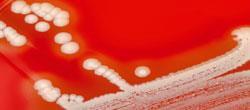Simon Cotton takes a look at those compounds that find themselves in the news or relate to our everyday lives.
Simon Cotton looks at compounds in the news or relating to our everyday lives.
In this issue: vancomycin
It's an antibiotic, isn't it?

It is the drug of last resort for MRSA (Methicillin-resistant Staphylococcus aureus, one of the hospital 'superbugs') and other cases where bacteria are resistant to all other antibiotics. There are now a few indications of resistance to vancomycin, and this presents a potentially serious health problem.
How does vancomycin work?
It inhibits bacterial cell wall synthesis, which stops the bacteria growing and dividing properly. The cell walls are made of strings of sugars, crosslinked by short peptide chains. By binding to D -alanyl- D -alanine groups on the end of the peptide chains, it stops the crosslinks forming. This prevents the bacteria from building its strong peptidoglycan network.
Doesn't penicillin do that?
Yes, but in a different way. Penicillin binds to the enzyme that makes the crosslinks. Instead of sabotaging the machinery that builds the cell wall, vancomycin is like a protestor sitting in the way.
So what's the problem?
When vancomycin binds to the D -alanyl- D -alanine terminus, it forms five hydrogen bonds (as well as various van der Waals interactions). Vancomycin-resistant bacteria have a different terminal sequence, replacing the final alanine with an ester link to lactic acid. This means vancomycin can only form four hydrogen bonds to it and produces other unfavourable interactions. The binding is a thousand times weaker, making vancomycin ineffective against these bacteria.
Is there an answer to the problem?
Dale Boger and his team at the Scripps Research Institute in California, US, have created a simpler form of the vancomycin molecule (lacking the disaccharide part). They have modified it by replacing an amide C=O oxygen with a C=NH group, so that it would bind to D -alanyl- D -lactate in the 'resistant' bacteria. In vitro tests show that this molecule is very active against both normal and resistant bacteria.
It now remains to be seen if this discovery can be applied to a real-life system.
References
- J Xie et al, J. Am. Chem. Soc., 2011, 133, 13946 (DOI: 10.1021/ja207142h)









No comments yet